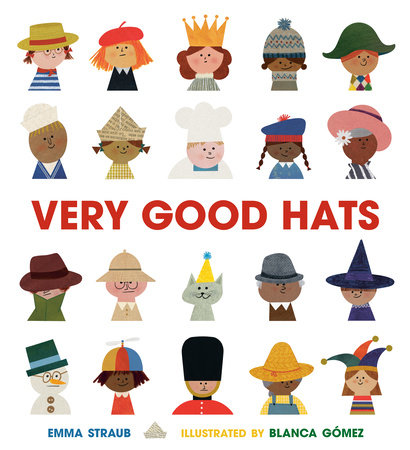Very Good Hats Is a Playful Exploration of Imagination
by Elizabeth Harrison
People wear many hats, both literally and metaphorically. As a theatre kid, I loved the hats I got to wear in my various roles: a Christmas caroler’s velvet beret, the Tin Man’s silver metal funnel, and a farm girl’s floral bonnet, to name a few. As a mom, my most donned hat is a baseball cap, but I’ve also worn a diaper hat, a dandelion-flower crown, and a picture book on my head. There’s something about an unexpected object on the noggin that is quite funny and likely to induce joy and laughter.
Very Good Hats by Emma Straub playfully explores the concept of a hat. What qualifies as a hat? More than you probably think! As the book reads, “Some people think hats are fancy things that you can buy at a haberdashery, but that’s just the tip of the iceberg.”
Straub’s debut children’s book shows readers how acorns can be hats for fingers, clouds can be hats for an airplane’s passengers, and a lid can be a hat for a pot. My toddler’s favorite featured hats include the “soup hat” (the hat you get when an empty bowl hat turns out to be full of soup) and the “ice cream hat” you can get at a baseball stadium.
It’s hard to imagine this book being illustrated by anyone else. Blanca Gómez’s illustrations are, as always, truly delightful. Her distinctive style and color palette are charming and add to the playful, quirky vibe of the title.
Wearing my “teacher hat,” my mind swims with ideas for using this book with children. It would be an excellent kick-off for exploring different jobs and their required tools. Many jobs are easily recognizable by their hats and uniforms, and Very Good Hats showcases several of these, including a pirate, firefighter, and chef. Take the title further by encouraging readers to consider how someone’s hat influences how they see and interact with the world. Perspective is a needed skill in today’s world.
Additionally, adults can use this book with children to inspire divergent thinking and healthy debate. This title asks readers, “If a turtle can tuck its head into its shell, does that make its shell a hat?” Consider with your reader what else they could consider a hat. Is a lampshade a hat for a lamp? Is the sun a hat for our planet? Explore objects that typically go on heads but aren’t considered hats. For example, why is a hairbow not a hat? How about a wig or even our hair? This book offers an opportunity to practice categorizing and comparing.
The book ends with the reminder, “Anything can be a hat if you believe it is.” In a world that can feel so heavy and polarized, let’s raise children who think outside the box and embrace joy and whimsy. Very Good Hats is an excellent place to start.




